Marine News' Top Vessels of 2023
The November edition of Marine News magazine highlighted a selection of the most notable American newbuilds delivered of 2023—from a first-of-its-kind green towboat, to the lead vessel in a series of game-changing ships to train U.S. mariners.
Empire State
As the lead vessel in a series of five new training ships being constructed to serve America's state maritime academies, Empire State is easily one of the most important U.S.-built vessels delivered in recent memory.
Built by Philly Shipyard for the U.S. Department of Transportation's Maritime Administration (MARAD) under its National Security Multi-Mission Vessel (NSMV) program, Empire State arrived to the Bronx, N.Y. in September in preparation to help train the next generation of U.S. mariners attending SUNY Maritime College.
In 2015, MARAD engaged with the U.S. Department of Transportation’s Volpe Center to make the business case for the recapitalization of the state maritime academy training fleet. The results of the study indicated that if the government failed to take action by 2025, three of the existing training vessels would be inoperable, spelling “long-term negative impact on national security, reducing the number of credentialed mariners available to operate U.S. vessels during war, national emergencies, and for domestic and international commerce.”
That same year, MARAD began work with Herbert Engineering to develop a design for what would eventually become the NSMV. The demands on the design would be significant. In addition to have to physically fit in the berths available at the state maritime academies, and serve as a state-of-the-art training platform for up to 600 cadets at sea, the vessel design would also have to accommodate use as a humanitarian aid and disaster relief (HA/DR) platform. State maritime academy vessels being used to support HA/DR missions was, of course, not a new concept. For example, in 2012, the Kennedy from the Massachusetts Maritime Academy and the previous Empire State from SUNY Maritime College were used to house disaster relief workers during the Hurricane Sandy clean-up effort. The difference, of course, is that the NSMV was designed to specifically support HA/DR operations, incorporating a roll-on/roll-off side ramp, container space, onboard cargo handling equipment, a helipad and berthing for up to a 1,000 people.
The result was a mature design, which together with the business case from Volpe, allowed MARAD to receive Congressional funding to begin the NSMV program in earnest. However, Congress saw the value of partnering with private industry to efficiently construct these next generation dual-purpose vessels. Accordingly, the National Defense Authorization Act for Fiscal Year 2017, required “an entity other than the Maritime Administration to contract for the construction of” the NSMVs. The stated Congressional goal was to “leverage the ship construction expertise of… a commercial operator when contracting for the construction of the vessel.”
This Congressional direction led to a MARAD Vessel Construction Manager (VCM) contract award to TOTE Services in 2019, leveraging their deep experience in commercial vessel construction. In turn, TOTE Services awarded the initial vessel construction contract in April 2020 to Philly Shipyard to build the first two vessels. The next two vessels in the NSMV program were ordered in 2021, followed by the fifth and final vessel in 2022.
The government sponsored shipbuilding program is the U.S.' first to utilize the VCM model, which places the responsibility for the selection and oversight of the shipyard on a government contractor that utilizes commercial best practices to manage the project. By all accounts, the program has been heralded as a success.
The new Empire State represents a radical technological upgrade for SUNY Maritime, as it replaces a ship that is more than 60 years old.
Starting in the machinery space, Empire State has a modern diesel-electric power plant, built with redundancy in that there are two separate engine rooms with a pair of diesel generators in each, both feeding dual high voltage switchboards and dual propulsion motors.
Power onboard consists of Wabtec Corporation's 16V250MDC, EPA Tier 4, IMO Tier III marine diesel engines designed to provide the power generation for the ships' electric grid, including the power and propulsion system. For the NSMV series, Wabtec will deliver a total of 20 x 16V250MDC Wabtec EPA T4 marine diesel engines plus accessories to its channel partner, Cummins Sales & Service, who has the job of packaging the engines into marine gensets for the five vessels.
The NSMV series and all of its modern technology will help to prepare the coming generation for real world sailing and the tech they will enter on working vessels.
The second vessel of the NSMV series, Patriot State, is destined for the Massachusetts Maritime Academy and scheduled for delivery in 2024. Philly Shipyard recently laid the keel for State of Maine (Maine Maritime Academy) and cut first steel for Lone Star State (Texas A&M Maritime Academy), and the yard is slated to begin construction for the fifth NSMV (California Maritime Academy) later this year for delivery in 2026.
Length: 525 ft.
Breadth: 88.5 ft.
Depth: 55.1 ft.
Draft, design: 21.4 ft.
Range: 10,000+ miles @ 18 knots
Propulsion: Diesel Electric
Engines: Wabtec (4) separated in two engine rooms
Total installed power: 16,800 kW
Emergency generator: 900kW
Electric propulsion motors: 2 sets in series with an output of 9,000 kW
Full speed: 18 knots with 15% sea margin
Cruising speed: 12 knots with 15% sea margin
Bow thruster: 1800 kW, retractable
Stern thruster: 890 kW
Rudder: Flat type
 Green Diamond (Photo: Kirby Corporation)
Green Diamond (Photo: Kirby Corporation)
Green Diamond
The United States' first plug-in hybrid electric inland towing vessel, christened at a ceremony in Houston in August, arrives as the commercial marine industry continues to implement new technologies to reduce its environmental footprint.
Kirby Inland Marine's Green Diamond will be time chartered by Shell Trading (US) Company, which will use the vessel to push barges throughout the Houston port region. According to Kirby, the vessel can achieve an estimated 80% reduction in fuel use and related emissions.
“We are excited to be the first to market with a plug-in hybrid inland towing vessel,” said Christian O’Neil, president of Kirby Inland Marine, a subsidiary of Houston-based Kirby Corporation. “Barge transportation is already the cleanest and greenest way to move a wide variety of cargoes in America, and we are working to make it cleaner and greener. Our customers who are focused on reducing their emissions want more efficient options. This solution is available today.”
Green Diamond’s hybrid electric propulsion system leverages the advantages of proven diesel-electric plants with the enhancement of new battery technology, O’Neil told Marine News. “Each inland towing vessel voyage is different, with stops at various ports and terminals, such that the vessel cannot depend upon returning to a known dock within a given timeframe. This rules out battery-only inland vessels for most trades, but the hybrid electric concept fits perfectly.”
“Hybrid electric plants have the added benefits of quieter operations enhancing crew comfort as well as enjoying the operational benefits of electric motors with their broad torque curves and responsiveness to throttle inputs,” O’Neil added.
Kirby leveraged in-house expertise to design and build the new vessel. Green Diamond was constructed by San Jac Marine, Kirby’s shipyard in Channelview, Texas. Another Kirby company Stewart & Stevenson Manufacturing Technologies designed and installed the power management, control and propulsion systems.
Chad Joost, executive vice president at Stewart & Stevenson, said the firm brought to the project power management expertise and a track record working with high horsepower electric systems in the oilfield. “We were able to adapt that patented technology to the marine environment and enable this vessel to operate on shore power and charge the batteries while on dock, then get underway on battery power. On extended trips, the generators will be used to supply power to the motors and charge the batteries. All of this happens seamlessly through Stewart and Stevenson’s power management system.”
Propulsion is provided by two 575 KW Danfoss electric motors that can be driven either by the Corvus Orca E2250V energy storage system, which provides 1,243 KWH of power, or, if needed, onboard Caterpillar C18 generators.
Norway-based Corvus Energy earlier this year opened a new factory Bellingham, Wash. in response to a “significant uptake in opportunities for maritime batteries from the U.S. market”.
“Inland towboats and tugs are ideal candidates for electrification with batteries because their routes are often shorter and closer to shore [where access to charging is available],” said Erik Larsen, Corvus Energy VP sales, Americas. “Recent electric vessel projects in the North American market include HaiSea Marine’s new battery powered escort and harbor tugs for a liquefied natural gas (LNG) export facility in Kitimat, and the Crowley eWolf tug currently under construction at Master Boat Builders.”
While designing and building a first-of-its-kind vessel such as Green Diamond can be difficult, a limited regulatory guidance for Sub-Chapter M hybrid-electric vessels and how to work that guidance into the design of a vessel presented its own set of challenges, O’Neil said. “Supplier partnership and collaboration was critical was early and proactive engagement with the U.S. Coast Guard and ABS. Given the breadth of ‘new territory,’ all stakeholders in this project took a significantly more involved approach than is typically required with established, conventional vessel types.”
A Shell-owned Zinus charging system will be used for dockside charging of the battery system, allowing the vessel to complete trips within the Houston area without using its generators, O’Neil said. Shell Energy Solutions will provide electrical power matched 100% by Green-e certified renewable energy certificates to charge the vessel’s battery system.
“This really puts the ‘green’ in Green Diamond,” O’Neil said. "Operationally, the vessel can and will operate in any and all areas and types of service as a conventional inland towing vessel. It is not restricted if shore charging infrastructure is not available. Even without shore-charging, it will see a greater level of fuel efficiency and emissions reductions than a conventional vessel."
According to Kirby’s modeling, when operating on shore supplied power, the fuel use can be reduced by almost 80%, resulting in an estimated 88-95% reduction in emissions of nitrous oxides, carbon monoxide and hydrocarbons. Engine run time can be reduced between 93 and 98% compared to a conventional inland towing vessel, Kirby said. When in hybrid mode with the generators running, the towboat is expected to have an estimated 27% reduction in emissions compared to a conventional towing vessel, the company added.
Maarten Poort, Shell’s general manager for shipping and maritime in the Americas, said, “The Green Diamond demonstrates how industry can collaborate to make strides towards profitable decarbonization in the shipping sector. It’s concrete action in the right direction—with recognition by those involved that leveraging innovation for lower-carbon outcomes is critically important for our industry, for our companies, for our communities.”
“The plug-in hybrid design offers numerous advantages for towboats in certain trades,” said Mitch Jones, vice president of San Jac Marine. “We are already looking at building follow-on vessels.”
Asked whether Green Diamond will lead the way for more plug-in hybrid electric towboats in Kirby’s fleet, O’Neil said, “Green Diamond has been an incredible project of which we are extremely proud. There are operational and environmental benefits to the design, and we are exploring future possibilities across a range of options.”
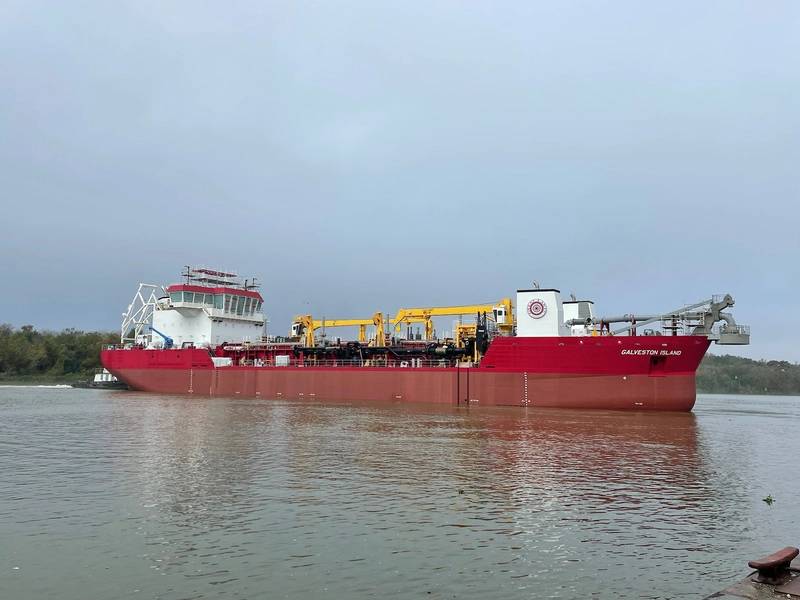 Galveston Island (Photo: Great Lakes Dredge & Dock)
Galveston Island (Photo: Great Lakes Dredge & Dock)
Galveston Island
Delivered this year amid an ongoing dredge building boom in the United States, Galveston Island is the first in a series of two new 6,500-cubic-yard-capacity trailing suction hopper dredges (TSHD) designed by C-Job and constructed by Conrad Shipyard for Great Lakes Dredge & Dock Corporation as part of the Houston-based dredging contractor’s fleet renewal program.
Chris Gunsten, SVP of project services and fleet engineering, Great Lakes Dredge & Dock, said the hopper dredge excels at working in offshore conditions and is particularly suited for coastal restoration and beach nourishment. “One really important factor of that type of work is being close to shore to limit your pumping distances,” he said, noting the dredge’s relative shallow draft for its capacity allows it to get closer to the beach, to be more efficient and to use less energy to get the work done.
Central to Galveston Island’s efficiency are its Wabtec EPA Tier 4 powerplants, engines that achieve performance without the need for urea. “We wanted to get as efficient as possible without the need for the urea after treatments that are at costly and cumbersome to manage at times,” Gunsten explained. “These engines also have the biofuel capacity. That's not widely available in a lot of markets [now] but they have that option.”
The removal of aftertreatment, according to Patrick Webb, senior director sales - global marine and stationary at Wabtec, makes the system smaller and simpler for the customer. “So we reduce that cost, that operation complexity and make it much simpler to operate with a plug-and-play medium speed 900 RPM engine system,” he said. “We've tried to make build and design this engine to fit in a lot of our competitor's footprints from the last 50 years of legacy engines.”
Urea tanks can range up to 10,000 gallons, compounded by a USCG requirement for crawl spaces around the tanks in the event of a leak, Webb noted. “[Urea tanks are] big structures that are very expensive to build; that goes away with the Wabtec Tier 4. We don't have those tanks, so designers can use that space for carrying capacity. If it's a hopper dredge, they can have larger hoppers,” Webb said.
In confirming the engine choice, Gunsten said, “In essence, the hopper dredge is a cargo vessel and it works on a cyclical basis multiple times per day. So, the more sand we can carry, the better off we are. Minimizing weight is an important consideration for that type of vessel and it links right into the reduced weight of the engine as well as the lack of the after treatment (weight).”
The dredge is equipped with a direct high-power pump-ashore installation, dredging system automation, dynamic positioning and tracking. Gunsten reckons that more than ever software and cloud computing are central to dredging efficiency. “Having a new modern vessel with a modern dredge control and monitoring system (DCMS) allows us to optimize,” he said. “Bridging on that and working into this new cloud-based world, she can broadcast that data and we can access that anywhere in the world, specifically here at our headquarters in Houston, where we plan to set up a data center to look at that information and have our experts analyze that real time. [This means] there's no lag in those optimizations [and we] get the most out of the investment in this new vessel.”
The newbuild will replace one of the older hopper dredges in the Great Lakes fleet, Terrapin Island, which is scheduled to has been taken out of service following a 42-year working history. A sister-ship to Galveston Island is currently under construction at Conrad, with steel cut in late 2022 and expected delivery in 2025.
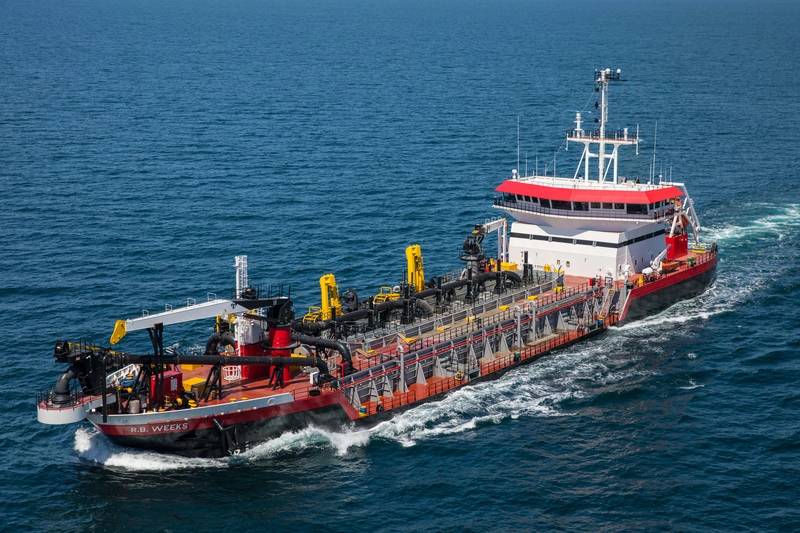 R.B. Weeks (Eastern Shipbuilding Group)
R.B. Weeks (Eastern Shipbuilding Group)
R.B. Weeks
Florida shipbuilder Eastern Shipbuilding Group (ESG) this Spring delivered R.B. Weeks, a 8,550 cubic yard capacity trailing suction hopper dredge constructed for Weeks Marine, based in Cranford, N.J.
“It’s our pleasure to once again deliver a quality vessel on time and on budget to our valued customers at Weeks Marine, Inc.,” said ESG’s CEO and chairman of the board, Joey D’Isernia. “The R.B. Weeks joins an impressive fleet that works alongside the Army Corps of Engineers to preserve our treasured waterways.”
Despite building the vessel through the height of the COVID-19 pandemic, ESG’s workforce was able to deliver the vessel on schedule. The Royal IHC-designed R.B. Weeks was constructed at ESG’s Allanton Shipyard and was launched on June 17, 2022. The vessel outfitting and trials were conducted at ESG’s Port St. Joe Shipyard.
According to Weeks Marine president and CEO Eric Ellefsen, the delivery of R.B. Weeks is a significant milestone for the company and the largest capital investment in Weeks Marine history, which spans over a century. “We look forward to putting the R.B. Weeks to work deepening and maintaining navigation channels, restoring storm-damaged coastal barrier islands and nourishing beaches lost to erosion, aiding the U.S. Army Corps of Engineers and other key clients,” he said at the time of delivery.
The R.B. Weeks is named in honor of Richard B. Weeks, a co-founder of Weeks Marine and married to Magdalen Weeks, the namesake of the nearly identical sister vessel Magdalen (ESG 256), built by ESG and delivered in 2017.
Like the Magdalen, R.B. Weeks includes a top-tier dredging machinery package by Royal IHC which includes dynamic positioning and powerful dredge and jet pumps that will efficiently load and unload the vessel. R.B. Weeks has a hopper capacity of 8,550 cubic yards and includes an electrical power, propulsion, and dredge machinery package by Royal IHC. It is equipped with twin Wabtec (GE) 16V250 MDC IMOIII/EPA Tier 4 engines driving a pair of Wartsila controllable pitch propellers (CPP) in nozzles through Siemens (Flender) reduction gears, as well as a Wartsila fixed pitch tunnel unit bow thruster, two Hyundai main generators, GE 6L250 MDC IMOIII/EPA Tier 4 / Hyundai auxiliary generator and Caterpillar C18 IMOII/EPA Tier 3 emergency generator.
With capacity for 26 persons on board, the dredge boasts several accommodation and crew comfort upgrades. It is classed by Lloyd’s Register (+100A1 Hopper Dredger, +LMC, UMS).
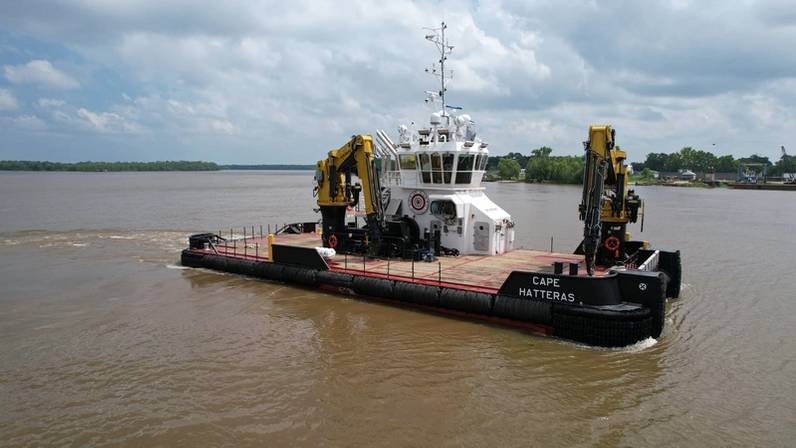 Cape Hatteras (Photo: Great Lakes Dredge & Dock Corporation)
Cape Hatteras (Photo: Great Lakes Dredge & Dock Corporation)
Cape Hatteras & Cape Canaveral
Damen’s Multi Cat multipurpose workboat design, well proven in European markets, has made its entry into the U.S. Jones Act market with the construction of two new workboats—Cape Hatteras and Cape Canaveral—for Houston-based dredging contractor Great Lakes Dredge & Dock.
While the Netherlands-based Damen does not physically build for the Jones Act market, it commonly licenses its designs for U.S. yards to build. Earlier this year, Conrad Shipyard in Morgan City, La. delivered Great Lakes’ two new Damen 3013 Multi Cats under this arrangement.
Offered in several configurations and sizes ranging from roughly 41 feet to 120 feet, the Multi Cat can be categorized as a utility/support vessel, often described as a “Swiss Army Knife” type of workboat, engineered for heavy-duty work in inland and nearshore shallow water settings, or deeper waters farther from shore.
“The Multi Cats are designed as multifunctional tools for maritime construction and dredging support,” a Damen spokesperson told Marine News when the vessels were ordered in 2021. “The barge-like hull shape provides a lot of deck space for the works on deck, and also enhance the stability that these vessels need for their lifting capabilities, with their massive deck cranes that will be placed on board.”
Great Lakes’ new vessels measure approximately 99 feet in length and are each powered by three EPA Tier III Caterpillar C32 TTA engines capable of meeting speeds of 10.2 knots and will have maximum bollard pull of approximately 32 short tons.
For Great Lakes Dredge & Dock, which gained previous experience working with Damen Multi Cats over the course of several international projects, the newbuilds will be used as dredge support vessels, equipped with two large winches and two deck cranes to perform a wide range of tasks including handling submerged and floating pipelines as well as anchor handling and logistics supply.
Cape Hatteras and Cape Canaveral boost efficiency by allowing additional floating support equipment to be removed from the picture, said David Johanson, senior vice president for project acquisition and operations at Great Lakes Dredge & Dock. “For decades, dredging pipelines have been installed and maintained with an assortment of floating equipment, such as derricks, anchor barges, tugboats and pontoon tanks,” he explained. “The Multi Cats will improve our operating efficiencies by eliminating the need for multiple vessels to perform these tasks.”
Improved safety is another benefit. “The Multi Cat brings step change safety improvements to Great Lakes’ dredge pipeline operations, which was a prime driver for the investment,” said Chris Gunsten, Great Lakes’ senior vice president of project services and fleet engineering. “Pipe handling and connection work can now take place securely on deck, which will greatly reduce the risk of man overboards.”
“These vessels will also enhance and improve Great Lakes’ pipe and anchor operations. Further, the Multi Cats’ two crane and multiple winch and wire tugger arrangements will significantly reduce manual work and the risk of soft tissues injuries. These vessels support our strong safety culture and gives us the ability to dredge with enhanced operating efficiencies needed to maintain our shorelines and waterways.”
Damen vessels are often built to a stock design with options for modifications or enhancements. Being the first-of-their-kind U.S.-flag Multi Cats, Great Lakes’ new Damen workboats have been modified to meet regulatory requirements such as ABS Load Line, U.S. Coast Guard Subchapter M, Jones Act and U.S. Army Corps of Engineers requirements, Johanson said. “Our internal team of mechanical engineers and naval architects collaborated with Damen and Conrad Shipyards to meet all regulatory requirements, and also to improve the workability and safety of the vessels.”
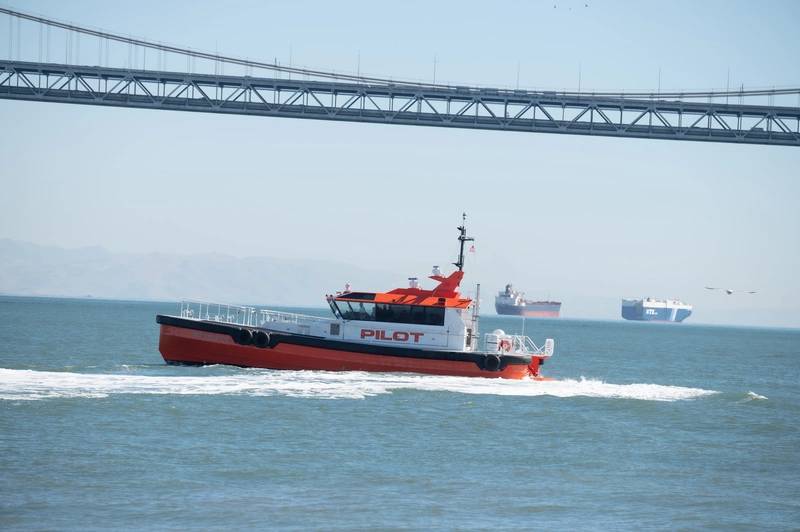 Golden Gate (Photo: San Francisco Bar Pilots)
Golden Gate (Photo: San Francisco Bar Pilots)
Golden Gate
The San Francisco Bar Pilots provide pilotage service in the San Francisco Bay and tributaries. When it came time to build a new launch to replace one of their older vessels, they sought a design that’s proven, safe and heavy weather capable. They also needed a vessel that could live up to their operational speed and endurance demands while also complying with U.S. EPA Tier 4 and California Air Resources Board (CARB) emissions requirements.
What they ended up with was Golden Gate, a 67-foot-long, all-aluminum pilot boat with a double chine hull, designed by Camarc Design in the U.K. and built by Seattle’s Snow & Company. The vessel entered service in September, and based off pilot feedback, it’s safe to say the new launch has met their demands.
“Camarc Design is a well-known pilot boat architect, and the new Refined Hull model is an excellent pilot transfer platform,” said San Francisco Bar Pilots’ Capt. David McCloy, who was integral in the design and construction processes of the new vessel. “The builder, Snow & Company, has been a great partner in the project, and they have provided our group with a high-quality pilot vessel,”
Powered by a pair of MAN D2862 LE 438 1,200HP U.S. EPA Tier 4 engines that drive Hamilton HTX52 waterjets through Twin Disc MGX 6599 SC gearboxes, Golden Gate is capable of hitting 32 knots at top speed and cruises at 25 knots at 85% MCR. The vessel is also equipped with two Northern Lights M944T3F 38kW generators.
With onboard capacity for two crew and up to 12 pilots, the new Golden Gate—which replaces a 30-year-old vessel of the same name—is a quiet, comfortable work platform, McCloy said. The boat, at 73 feet LOA including jets and platform, with a 20-foot beam and 4-foot draft, features Humphree interceptors for a smoother ride, and sound levels at full throttle are 64dBA. A robust HVAC system provides fresh air and humidity control in the wheelhouse. For safety, Golden gate is equipped with an improved hydraulic man overboard recovery system.
“The pilot's reactions have been very positive. Fit and finish of the vessel, comfort, ride quality, low noise and vibration and excellent visibility are the biggest highlights,” McCloy said. “One of the main priorities of the project was noise reduction, comfort and ergonomics for the crew. Our boat crews work long shifts for years on our vessels, and there are negative long-term effects of high noise and vibration environments.”
The vessel features Furuno FR 2228BB/NXT radar, Furuno FA170 AIS, Furuno SC70 GPS, Furuno SC70 GPS compass and Ritchie mag compass, Furuno FM8900S radar, Rotheta RT-500-M integrated radio direction finder with Luminell CLITE2 IR LED searchlight and FLIR camera for MOB, Boning command and control system with flat panel touch screens for systems operation, alarm monitoring, Rose Point ECS electronic navigation and CCTV/FLIR cameras.
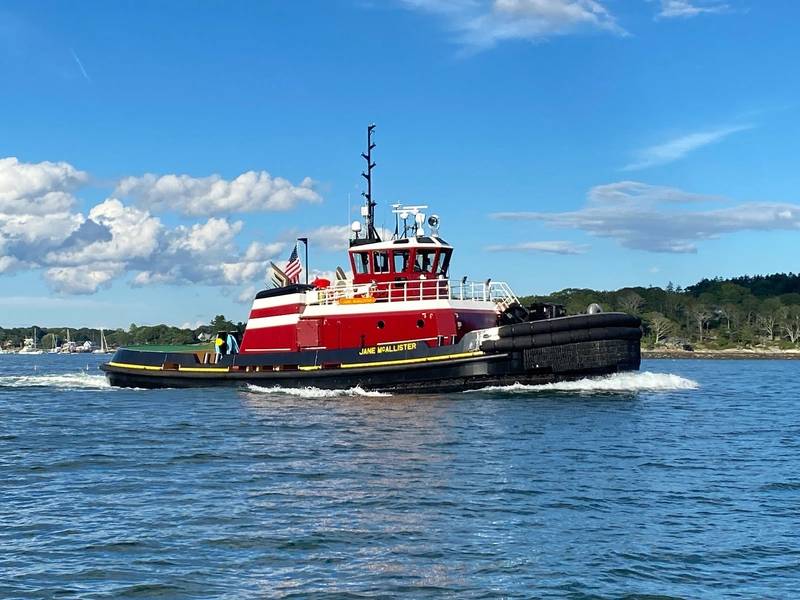 Jane McAllister (Photo: McAllister Towing)
Jane McAllister (Photo: McAllister Towing)
Jane McAllister
McAllister Towing’s new tug Jane McAllister entered service this summer as one of the most advanced and powerful shipdocking tractor tugs operating in the Port of Virginia.
Constructed by Washburn & Doughty Associates, Inc. in East Boothbay, Maine, the 6,770-horsepower vessel packs a punch, equipped with 3516E Tier IV Caterpillar engines powering twin Schottel SRP 490 Z-drive units. The 93- by 38-foot tug features Markey winches on the bow and stern and achieved over 91 short tons during its ABS bollard pull certification.
McAllister president and CEO, B. Buckley McAllister, said, "We are proud that the Jane is the 10th tug in our fleet with over 80 metric tons of bollard pull and escort capability, making our fleet one of the best in the country for the larger ships entering into service."
When the Port of Virginia’s dredging and widening program is complete in 2024, the Norfolk Harbor will offer the deepest, widest channels on the U.S. East Coast and commercial channels will allow safe, two-way traffic for fully laden ultra large container vessels.
"The Jane will not only meet, but exceed the needs, handling the ever-increasing size of vessels calling Virginia. This tug is joining our fleet of six other tractor tugs, and will enable us to continue safely handling the gentle giants calling the Port of Virginia," said Captain J. Elliott Westall, McAllister Towing of Virginia’s vice president and general manager. "Having exceptional control and power, the Jane is the new 'Queen of Hampton Roads', and everyone that works on or with her can be confident in her abilities to deliver unsurpassed service for our customers."
 Shackleford (Photo: All American Marine)
Shackleford (Photo: All American Marine)
Shackleford
Built to service the growing offshore wind market as well as accomplish many other scientific survey missions, Shackleford is a 73- by 26.7-foot aluminum research and hydrographic survey vessel constructed by Bellingham, Wash. shipbuilder All American Marine (AAM) for the growing fleet of Geodynamics, an NV5 company.
Designed by Nic de Waal of Teknicraft Design in Auckland, New Zealand specifically for site development and cable surveys for offshore wind and telecommunications for extended 12- or limited 24-hour operations, the newbuild leverages fundamental design elements of the Duke University Marine Lab’s Shearwater and Blue Tide Puerto Rico’s Blue Manta—both built by All American Marine for operations in near-coastal research environments. The Shackleford integrates Teknicraft’s signature symmetrical and asymmetrical combined hull shape, bow wave piercer and a patented hydrofoil-assisted hull design. The hull and hull components are designed to break up wave action and ensure reduced drag while enhancing passenger comfort and survey conditions.
From its homeport of Beaufort, N.C., Shackleford will serve an integral role in Geodynamics’ mission of providing turnkey single pass offshore surveys and has been specifically customized to perform specialized nearshore and mid-shelf hydrographic and geophysical survey operations for the burgeoning offshore wind sector on the U.S. Eastern Seaboard.
To reduce survey mobilization costs, Shackleford is outfitted with fully dedicated and redundant survey systems, including a Kongsberg EM 2040 MKII multibeam echosounder deployed through the vessel’s moonpool via retractable strut. Dimensional Control (DimCon) surveys utilizing applied metrology techniques orient the Shackleford’s primary IMU/multibeam reference systems, and a network of discrete benchmarks set within the vessel’s reference frame allowing accurate and repeatable lever arm calculations to all survey sensors. Coordinate Uncertainty Analysis of the final DimCon survey establishes an overall RMS of 0.0001 meters between all established points within the network.
“To achieve the highest level of data accuracy day in and day out, our model over the last two decades is simple: we consider the boat as a precision survey instrument, purpose built for the specific survey environment and then wrapped around the ideal sensors for a specific set of missions,” said Chris Freeman, SVP at Geodynamics. “This new best-in-class vessel will provide an unmatched platform for our continued focus performing to the most stringent offshore survey specifications in the world, whether that is for nautical charting or for subsea exploration to support offshore wind development.”
Capable of 18- to 24-knot cruising speeds, Shackleford is equipped with twin EPA Tier 3 Caterpillar C-18 diesel engines rated at 803 hp at 2,100 RPM that drive two fixed pitch propellers through ZF 665V remote mounted gearboxes. The vessel has two 21 kW Northern Lights generators.
With a large fuel capacity of 1,500 gallons, this fuel-efficient design is licensed for up to 16 day passengers and has live-aboard accommodations of up 10 passengers. On board the vessel, passengers and crew have comfortable quarters, large state-of-the-art lab spaces, and a full range of hydrographic and marine geophysical instrumentation. Shackleford offers five dedicated computer stations, three bunkrooms, two heads and a full galley.
Ron Wille, All American Marine president & COO, said, “This vessel will enable Geodynamics to take their business to the next level, provide unmatched services and expand their scientific activities on the east coast significantly. The vessel will also help advance the rapidly growing windfarm industry on the East Coast and beyond.”
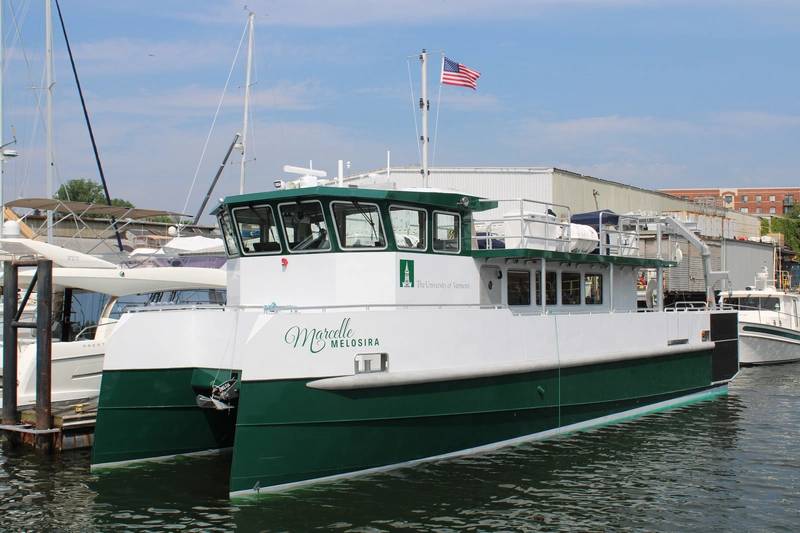 Marcelle Melosira (Photo: Derecktor Shipyards)
Marcelle Melosira (Photo: Derecktor Shipyards)
Marcelle Melosira
Marcelle Melosira is a research and teaching vessel operated by the Rubenstein School of Environment and Natural Resources at the University of Vermont (UVM). The 64-foot-long aluminum catamaran was designed by Chartwell Marine in the U.K. and built by Derecktor Shipyards in Mamaroneck, N.Y. to serve as a floating classroom and laboratory on Lake Champlain.
Notably, the boat runs on a Hybrigen propulsion system engineered by BAE Systems for lower emissions and reduced fuel burn. The diesel-electric hybrid system features two electric motors, lithium-ion batteries and two 306-horsepower Cummins diesel generators. For added efficiency, the vessel boasts a custom catamaran hull construction designed to minimize resistance on the hull and ensure stability in windy conditions. The vessel is also equipped with dual control stations to maximize operability, and offers a large interior space and an expansive exterior aft deck area.
“The new hybrid electric vessel is one of the first of its kind for research and teaching, fully equipped to expand UVM's cutting-edge world-class research, deliver hands-on education programs to students of all ages, and welcome the public to learn about the mysteries, wonders and significance of our great Lake Champlain,” said Jason Stockwell, director of the Rubenstein Ecosystem Science Laboratory.
While the vessel will be used for limnological, fisheries and geophysical research, it will also host public outreach trips with partner organizations, including many hands-on educational trips for regional K-12 schools. The vessel can accommodate up to 29 passengers and three crewmembers, a 10-person capacity upgrade over the previous vessel.
Marcelle Melosira features a modular laboratory classroom that can easily be reconfigured to support evolving scientific and teaching needs. A first-of-its-kind electric winch, designed by engineers at the Woods Hole Oceanographic Institution, is located on the topside deck and is essential for deploying scientific instrumentation such as water column profilers, camera systems and plankton nets. The vessel will also facilitate the launch and recovery of small remotely operated vehicles (ROV).
Stockwell described the vessel as an incredible resource for students, community partners and researchers. “With increased capacity, state-of-the-art equipment, and an improved classroom environment onboard, the Marcelle Melosira greatly enhances our ability to do impactful research and education.”











